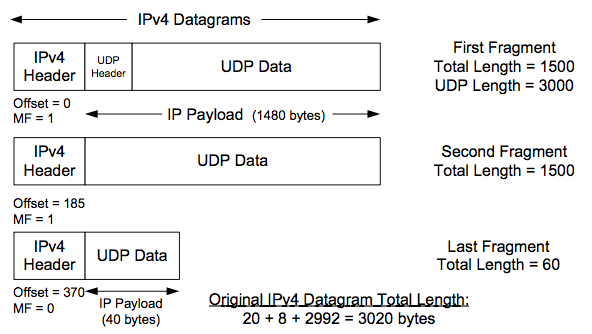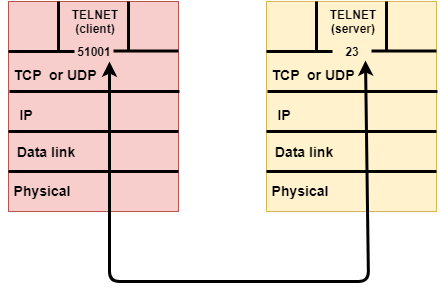Reassemble Udp Packets Multiprocess
Assume A has a UDP segment of 10000 bytes to send to B. A chops down these 10000 bytes into each 1000 bytes chunk and sends total 10 packets to B, each carrying 1000 bytes as IP pay load. B will wait for all the 10 packets, once all received, B ( ip layer) reassembles them into a UDP segment of 10000 bytes and gives it to UDP layer for processing. Connecting CA APM to Multi-Port Monitor allows you to view high-level network performance information related to the application being monitored. For the defect you are viewing, network data from the Multi-Port Monitor database is imported to the CEM console and saved in the APM database.
Host A sends a 1400 byte IP packet to Host B over an Ethernet and PPP link. The PPP link has an MTU of 532 bytes, which means that the IP packet will be fragmented into 3 smaller packets.Fragment 1 is received first. It has a unique ident and the M bit flag is set, indicating there are more fragments to come. However, fragment 3 is received next, due to some re-ordering in the network. This fragment has the same ident as fragment 1, but the M bit is not set, because it's the last fragment. Fragment 2 is received shortly after.What will the receiving host do?.Will the receiving host know that the offset and packet length do not match up, and assume an intermediate packet has been either dropped or re-ordered in the network, and wait for it?.Will the receiving host reassemble the packet (both the header checksums match) and pass it to the higher layer (where it will fail an IP checkum over the data if using UDP/TCP).Will the receiving host drop all fragments for this ident.
The receiving host knows that there are lost fragments and waits until a reassembly timeout expires. Unless the lost fragments arrive, the fragments are dropped.RFC 791 in section 3.2 defines that:If the timer runs out, the all reassembly resources for this buffer identifier are released. The initial setting of the timer is a lower bound on the reassembly waiting time.
This is because the waiting time will be increased if the Time to Live in the arriving fragment is greater than the current timer value but will not be decreased if it is less. The maximum this timer value could reach is the maximum time to live (approximately 4.25 minutes). The current recommendation for the initial timer setting is 15 seconds.This reassembly timeout for IPv4 and IPv6 on Linux is 30 seconds and for Windows (Vista, 2008, 7 and 2008 R2) is 60 seconds according to section 4.5 of:If insufficient fragments are received to complete reassembly of a packet within 60 seconds of the reception of the first-arriving fragment of that packet, reassembly of that packet must be abandoned and all the fragments that have been received for that packet must be discarded.
@GeorgeRobinson, if I'm understanding your question correctly, yes, the higher the timeout is in the protocol stack, the shorter the timeout must be, because if a lower layer timeout occurs first, the higher layer will never get the opportunity to handle it. I had a webservice which accesses a database and absolutely MUST return false if any failure occurs, but due to issues on the hoster end, during times of high usage, the DB connection would time out. I had to arrange the timeouts such that the DB timeout was assumed before the SOAP timeout window occured so that the caller would get False–Apr 9 '15 at 14:08.
The TCP/IP Guide - IP Message Reassembly ProcessPlease Whitelist This Site?I know everyone hates ads. But please understand that I am providing premium content for free that takes hundreds of hours of time to research and write. I don't want to go to a pay-only model like some sites, but when more and more people block ads, I end up working for free. And I have a family to support, just like you.:)If you like The TCP/IP Guide, please consider. It's priced very economically and you can read all of it in a convenient format without ads.If you want to use this site for free, I'd be grateful if you could add the site to the whitelist for Adblock. To do so, just open the Adblock menu and select 'Disable on tcpipguide.com'. Or go to the Tools menu and select 'Adblock Plus Preferences.'
Then click 'Add Filter.' At the bottom, and add this string: '@@ tcpipguide.com^$document'.
Rtcp Packets

Then just click OK.Thanks for your understanding!Sincerely, Charles KozierokAuthor and Publisher, The TCP/IP Guide. 999991IP Message Reassembly Process(Page 1 of 2)When a datagram is fragmented, eitherby the originating device or by one or more routers transmitting thedatagram, it becomes multiple fragment datagrams. The destination ofthe overall message must collect these fragments and then reassemblethem into the original message. Reassembly is accomplished by usingthe special information in the fields we saw in the preceding topicto help us put the jigsaw puzzle back together again. Asymmetry of Fragmentation and ReassemblyIt's important to understand thatwhile reassembly is the complement to fragmentation, the two processesare not symmetric. A primary differentiation between the two is thatwhile intermediate routers can fragment a single datagram or furtherfragment a datagram that is already a fragment, intermediate devicesdo not perform reassembly. This is done only by the ultimate destinationof the IP message.
So, if a datagram at an intermediate router on oneside of a physical network with anof 1,300 causes fragmentation of a 3,300 byte datagram, the router onthe other end of this 1,300 MTU link will not restore the 3,000byte datagram to its original state. It will send all the 1,300 bytefragments on down the internet, as shown in.There are a number of reasons whythe decision was made to implement IP reassembly this way. Perhaps themost important one is that fragments can take different routes to getfrom the source to destination, so any given router may not see allthe fragments in a message. Another reason is that having routers needto worry about reassembling fragments would increase their complexity.Finally, as we will see, reassembly of a message requires that we waitfor all fragments before sending on the reassembled message.

Havingrouters do this would slow routing down. Since routers don't reassemblethey can immediately forward all fragments on to the ultimate recipient.However, there are drawbacks to thisdesign as well.
One is that it results in more smaller fragments travelingover longer routes than if intermediate reassembly occurred. This increasesthe chances of a fragment going missing and the entire message beingdiscarded. Another is a potential inefficiency in the utilization ofdata link layer frame capacity. In the example above, the 1,300-bytefragments would not be reassembled back into a 3,300 byte datagram atthe end of the 1,000-MTU link. If the next link after that one alsohad an MTU of 3,300, we would have to send three frames, each encapsulatinga 1,300-byte fragment, instead of a single larger frame, which is slightlyslower.Key Concept: In IPv4, fragmentation can be performed by a router between the source and destination of an IP datagram, but reassembly is only done by the destination device.1If you find The TCP/IP Guide useful, please consider making a small Paypal donation to help the site, using one of the buttons below. You can also donate a custom amount using the far right button (not less than $1 please, or PayPal gets most/all of your money!) In lieu of a larger donation, you may wish to.

Thanks for your support!Donate $2Donate $5Donate $10Donate $20Donate $30Donate: $-(Version Date: September 20, 2005Charles M. All Rights Reserved.